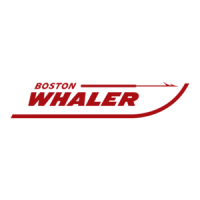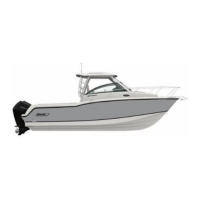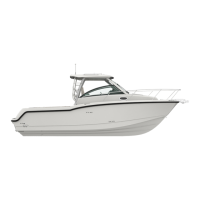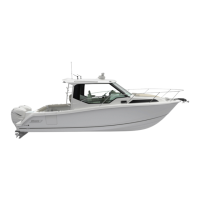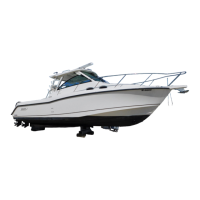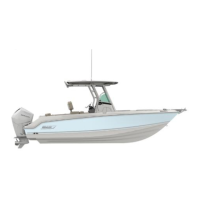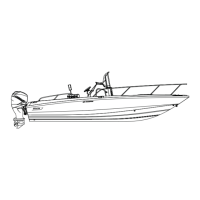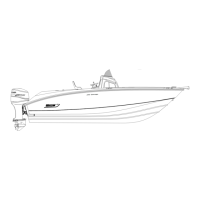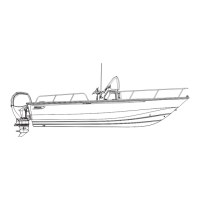Do you have a question about the Boston Whaler 235 Conquest and is the answer not in the manual?
Details provided in the manual and packet.
Operator's duties for safe boating.
Where to find boating courses and resources.
Information on boat and component warranties.
Contact details for Boston Whaler and authorities.
Full reimbursement for structural hull defects within 5 years.
Pro-rata reimbursement for structural hull defects after 5 years.
One-year warranty for factory-installed accessories.
Defines the exclusive remedy for warranty claims.
Time limit for legal actions against the warranty.
Exclusions and disclaimers for warranties.
Specific items and conditions not covered by the warranty.
Purchaser's responsibilities for warranty claims.
Process for registering the boat for warranty.
Conditions for transferring the limited warranty.
Understanding hazard symbols and their meanings.
Location and purpose of safety warning labels.
General safety advice for boat operation.
Pre-departure, trailering, and post-return checks.
Essential safety gear required by law.
Optional but recommended safety gear.
Dangers of operating a boat under the influence.
Hazards and prevention of carbon monoxide poisoning.
Importance and types of Personal Flotation Devices (PFDs).
Legal requirements for PFDs on board.
Different types of PFDs and their uses.
Safe procedures for boarding the boat.
Importance of operator attentiveness and boat handling.
Factors affecting boat handling and safety.
Procedures for medical emergencies, water rescue, and fire.
Measures to prevent and mitigate fires.
Actions to take during these hazardous events.
Procedures to follow in case of a boat collision.
Actions to take during loss of power or steering.
How to handle running aground and inspection.
Requirements and types of visual and audible signals.
Audible signals for distress and urgency.
Using VHF-FM and SSB for safety and communication.
Safety advice regarding weather conditions.
Safety guidelines for water sports.
Specific safety rules and signals for water skiing.
Function and use of the safety engine shut-off switch.
Importance and creation of a float plan.
Planning a safe route using charts and aids.
Managing fuel spills and noise pollution.
Responsibility for boat wakes and speed limits.
Rules for approaching naval vessels and security zones.
Program for reporting suspicious activities.
Identifying and understanding warning labels on the boat.
Explains symbols used in the manual and on controls.
Boston Whaler's commitment to quality and safety standards.
Description of the Unibond™ hull construction process.
Location and importance of the HIN.
Where to get service and maintenance work done.
Compliance with safety standards and capacity ratings.
Boat's design category based on wave and wind conditions.
Information on maximum engine power and weight limits.
Key physical measurements of the boat.
Detailed measurements and capacities of the boat.
Designated areas for passengers and deck occupancy.
Identification and function of hull fittings.
Overview of exterior features and components.
Description of standard equipment in the cabin.
Description of standard equipment on the console.
Description of standard equipment at the transom.
Description of standard equipment in the bilge area.
Overview of optional equipment available for the boat.
Optional features for the deck and cockpit.
Optional propulsion system upgrades.
Optional cabin features and amenities.
Optional hardtop features and accessories.
Optional canvas options and covers.
Optional electronic and navigation equipment.
Optional console electronics and features.
Enhanced optional electronics packages.
Optional equipment for fishing enthusiasts.
Locations and types of storage compartments.
Description and locations of all seating arrangements.
Location and function of the boat's switch panel.
Information center for boat operational data.
Initial setup and calibration of VesselView.
Operation of the digital throttle and shift system.
Proper use of navigation and anchor lights.
Function and use of the safety engine shut-off switch.
Adjusting engine trim for optimal performance.
How to use trim tabs for boat leveling and performance.
Operation of the waste discharge system.
Techniques for docking, lifting, and trailering the boat.
Identification of boat cleats and their use.
Proper methods for securing the boat to a dock.
How to tie a secure and releasable knot for docking.
Safe procedures for lifting the boat out of the water.
Considerations for trailering the boat.
Methods for safely tying down the boat.
Safety measures for connecting the trailer to the vehicle.
Operation and maintenance of the bilge pump system.
Regulations and procedures for handling fuel and oil spills.
Overview of the boat's gasoline fuel system.
Safety precautions during fueling to prevent static discharge.
Information and precautions regarding ethanol fuels.
Best practices for filling the fuel tank.
Causes and prevention of fuel phase separation.
Information on engine fuel filtration.
Preparing the boat and fuel system for storage.
Procedures for starting the boat's engine.
Safe methods for shutting down the engine.
Operation of the hydraulic steering system.
Overview of the boat's fresh water system.
Function and operation of the livewell system.
Using the raw water washdown system.
Environmental considerations for the marine head.
Using the dockside waste disposal facility.
Operation of the overboard waste discharge system.
Basic characteristics and selection of boat propellers.
Principles and practices of anchoring a boat.
Procedures for safely lowering the anchor.
Methods for properly setting the anchor.
Techniques for retrieving the anchor.
Operation and adjustment of the foldaway aft seat.
Overview of the boat's electrical system.
Information on battery types and care.
Operation of the battery selector switch.
Battery maintenance and safety precautions.
Location and replacement of fuses.
Function and reset of the main DC breaker.
Identifying and resetting component circuit breakers.
Specifics on breakers for console switches.
Technical diagrams of the boat's wiring.
Chart for identifying wire colors and functions.
Diagram of the switch and breaker panel layout.
Comprehensive diagram of the boat's DC wiring.
Wiring diagram for the optional windlass.
Wiring layout for the forward section of the boat.
Wiring layout for the port side of the boat.
Wiring layout for the port transom area.
Wiring layout for the starboard side of the boat.
General guidelines for cleaning the boat's exterior.
How to clean and protect the boat's hull.
Methods to prevent hull blistering.
Process and considerations for painting the hull bottom.
Annual inspection and cleaning of the painted hull.
Proper cleaning and maintenance for vinyl cushions.
Preparing the boat for extended storage.
Care and maintenance of the boat's engine.
Maintenance of fuel tanks, hoses, and pumps.
Procedures for storing the boat on its trailer.
Proper storage procedures for boat batteries.
Ensuring proper water drainage from the deck and bilge.
Draining and maintaining the raw water system.
Cleaning and maintaining canvas components.
Details provided in the manual and packet.
Operator's duties for safe boating.
Where to find boating courses and resources.
Information on boat and component warranties.
Contact details for Boston Whaler and authorities.
Full reimbursement for structural hull defects within 5 years.
Pro-rata reimbursement for structural hull defects after 5 years.
One-year warranty for factory-installed accessories.
Defines the exclusive remedy for warranty claims.
Time limit for legal actions against the warranty.
Exclusions and disclaimers for warranties.
Specific items and conditions not covered by the warranty.
Purchaser's responsibilities for warranty claims.
Process for registering the boat for warranty.
Conditions for transferring the limited warranty.
Understanding hazard symbols and their meanings.
Location and purpose of safety warning labels.
General safety advice for boat operation.
Pre-departure, trailering, and post-return checks.
Essential safety gear required by law.
Optional but recommended safety gear.
Dangers of operating a boat under the influence.
Hazards and prevention of carbon monoxide poisoning.
Importance and types of Personal Flotation Devices (PFDs).
Legal requirements for PFDs on board.
Different types of PFDs and their uses.
Safe procedures for boarding the boat.
Importance of operator attentiveness and boat handling.
Factors affecting boat handling and safety.
Procedures for medical emergencies, water rescue, and fire.
Measures to prevent and mitigate fires.
Actions to take during these hazardous events.
Procedures to follow in case of a boat collision.
Actions to take during loss of power or steering.
How to handle running aground and inspection.
Requirements and types of visual and audible signals.
Audible signals for distress and urgency.
Using VHF-FM and SSB for safety and communication.
Safety advice regarding weather conditions.
Safety guidelines for water sports.
Specific safety rules and signals for water skiing.
Function and use of the safety engine shut-off switch.
Importance and creation of a float plan.
Planning a safe route using charts and aids.
Managing fuel spills and noise pollution.
Responsibility for boat wakes and speed limits.
Rules for approaching naval vessels and security zones.
Program for reporting suspicious activities.
Identifying and understanding warning labels on the boat.
Explains symbols used in the manual and on controls.
Boston Whaler's commitment to quality and safety standards.
Description of the Unibond™ hull construction process.
Location and importance of the HIN.
Where to get service and maintenance work done.
Compliance with safety standards and capacity ratings.
Boat's design category based on wave and wind conditions.
Information on maximum engine power and weight limits.
Key physical measurements of the boat.
Detailed measurements and capacities of the boat.
Designated areas for passengers and deck occupancy.
Identification and function of hull fittings.
Overview of exterior features and components.
Description of standard equipment in the cabin.
Description of standard equipment on the console.
Description of standard equipment at the transom.
Description of standard equipment in the bilge area.
Overview of optional equipment available for the boat.
Optional features for the deck and cockpit.
Optional propulsion system upgrades.
Optional cabin features and amenities.
Optional hardtop features and accessories.
Optional canvas options and covers.
Optional electronic and navigation equipment.
Optional console electronics and features.
Enhanced optional electronics packages.
Optional equipment for fishing enthusiasts.
Locations and types of storage compartments.
Description and locations of all seating arrangements.
Location and function of the boat's switch panel.
Information center for boat operational data.
Initial setup and calibration of VesselView.
Operation of the digital throttle and shift system.
Proper use of navigation and anchor lights.
Function and use of the safety engine shut-off switch.
Adjusting engine trim for optimal performance.
How to use trim tabs for boat leveling and performance.
Operation of the waste discharge system.
Techniques for docking, lifting, and trailering the boat.
Identification of boat cleats and their use.
Proper methods for securing the boat to a dock.
How to tie a secure and releasable knot for docking.
Safe procedures for lifting the boat out of the water.
Considerations for trailering the boat.
Methods for safely tying down the boat.
Safety measures for connecting the trailer to the vehicle.
Operation and maintenance of the bilge pump system.
Regulations and procedures for handling fuel and oil spills.
Overview of the boat's gasoline fuel system.
Safety precautions during fueling to prevent static discharge.
Information and precautions regarding ethanol fuels.
Best practices for filling the fuel tank.
Causes and prevention of fuel phase separation.
Information on engine fuel filtration.
Preparing the boat and fuel system for storage.
Procedures for starting the boat's engine.
Safe methods for shutting down the engine.
Operation of the hydraulic steering system.
Overview of the boat's fresh water system.
Function and operation of the livewell system.
Using the raw water washdown system.
Environmental considerations for the marine head.
Using the dockside waste disposal facility.
Operation of the overboard waste discharge system.
Basic characteristics and selection of boat propellers.
Principles and practices of anchoring a boat.
Procedures for safely lowering the anchor.
Methods for properly setting the anchor.
Techniques for retrieving the anchor.
Operation and adjustment of the foldaway aft seat.
Overview of the boat's electrical system.
Information on battery types and care.
Operation of the battery selector switch.
Battery maintenance and safety precautions.
Location and replacement of fuses.
Function and reset of the main DC breaker.
Identifying and resetting component circuit breakers.
Specifics on breakers for console switches.
Technical diagrams of the boat's wiring.
Chart for identifying wire colors and functions.
Diagram of the switch and breaker panel layout.
Comprehensive diagram of the boat's DC wiring.
Wiring diagram for the optional windlass.
Wiring layout for the forward section of the boat.
Wiring layout for the port side of the boat.
Wiring layout for the port transom area.
Wiring layout for the starboard side of the boat.
General guidelines for cleaning the boat's exterior.
How to clean and protect the boat's hull.
Methods to prevent hull blistering.
Process and considerations for painting the hull bottom.
Annual inspection and cleaning of the painted hull.
Proper cleaning and maintenance for vinyl cushions.
Preparing the boat for extended storage.
Care and maintenance of the boat's engine.
Maintenance of fuel tanks, hoses, and pumps.
Procedures for storing the boat on its trailer.
Proper storage procedures for boat batteries.
Ensuring proper water drainage from the deck and bilge.
Draining and maintaining the raw water system.
Cleaning and maintaining canvas components.
| Deadrise at Transom | 20 degrees |
|---|---|
| Beam | 8' 6" |
| Maximum Horsepower | 300 hp |
| Person Capacity | 10 |
| Water Capacity | 20 gallons |
